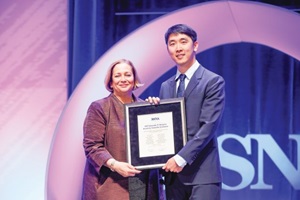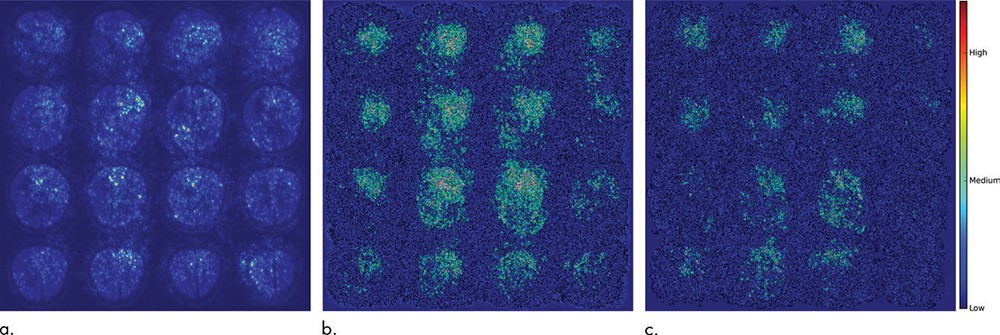AI-Powered Alzheimer’s Research Earns the Margulis Award
Study shows early prediction of Alzheimer’s using FDG PET to train algorithm

A passion for artificial intelligence (AI) and a quest to defeat Alzheimer’s disease (AD) inspired one researcher’s groundbreaking study showing the significant potential of AI as a diagnostic tool in AD.
A radiology resident with an engineering background, Jae Ho Sohn, M.D., from the Radiology & Biomedical Imaging Department at the University of California in San Francisco (UCSF), co-authored the 2018 Radiology study with the goal of developing a deep learning (ML) algorithm to detect patterns on complex brain images to identify AD as early as possible.
“Alzheimer’s is a costly, devastating disease and by the time a clinical diagnosis is made, it’s often too late,” said Dr. Sohn, who leads the UCSF Big Data in Radiology (BDRAD), a multidisciplinary team of physicians and engineers focusing on radiological data science. “We hypothesized we could use AI as an early prediction tool for Alzheimer’s in conjunction with other biochemical and imaging tests.”
The results far exceeded Dr. Sohn’s expectations. Using 18F fluorodeoxyglucose (FDG) PET scans to train an ML algorithm, Dr. Sohn and colleagues were able to detect early-stage AD about six years before it was clinically diagnosed.
“This research is groundbreaking,” said Radiology Editor David A. Bluemke, MD. “It demonstrates the potential for state-of-the-art AI technology to help interpret the remarkably complex patterns on FDG PET imaging in patients with Alzheimer’s disease. Even more hopeful for Alzheimer’s patients, this same line of research will also apply to more specific PET tracers for detecting the disease.”
For his Radiology research, Dr. Sohn received the Alexander R. Margulis Award for Scientific Excellence, which recognizes the top study published in Radiology in a given year. Dr. Sohn was presented with the Margulis Award at RSNA 2019.
Algorithm Achieves 100% Sensitivity
The study began when two of Dr. Sohn’s UCSF mentors — Benjamin Franc, MD, a nuclear medicine specialist, and Youngho Seo, PhD, a nuclear medicine physicist — approached him and undergraduate student Yiming Ding about developing an algorithm to interpret FDG PET brain scans.
Research has linked the disease process to changes in metabolism, which can be difficult to recognize. PET scans can measure the uptake of FDG in brain cells, indicating metabolic activity.
Dr. Sohn and colleagues used data from the Alzheimer’s Disease Neuroimaging Initiative (ADNI), a major multi-site study focused on clinical trials to improve prevention and treatment of this disease. The ADNI dataset included more than 2,100 FDG PET brain images from 1,002 patients. Researchers trained the DL algorithm on 90% of the dataset and then tested it on the remaining 10% of the dataset.
Finally, the researchers tested the algorithm on an independent set of 40 FDG PET imaging exams from 40 patients that it had never studied. Results showed that algorithm achieved 82% specificity and 100% sensitivity at detecting the disease an average of more than six years prior to the final diagnosis.
“I was surprised at how high the numbers were, but I already knew AI was going to be more effective than humans,” Dr. Sohn said. “The very special nature of AI detects very global, subtle changes that the human eye cannot.”
A Turning Point with Alzheimer’s
Dr. Sohn, who plans to continue researching the vast capabilities of AI in radiology, was extremely honored to be chosen for the Margulis Award, which he believes will open doors for future research.
“I was completely surprised and shocked to receive the award,” Dr. Sohn said. “This recognition will pave the way for my research career and will allow me to connect with other researchers doing important work.”
In terms of his Radiology research, Dr. Sohn stresses that further validation with larger and prospective external tests must be performed before the algorithm can be used clinically.
“We demonstrated early prediction of Alzheimer’s on a widely available imaging modality, but the study is a jumping-off point for further research,” he said. “If we can detect the disease early enough, physicians have a chance of slowing it down or halting it through therapeutic intervention.”
While there is still much work to do, Dr. Sohn believes that researchers united in the fight against Alzheimer’s are on the brink of a significant breakthrough.
“I really think we are at an inflection point with Alzheimer’s disease,” Dr. Sohn said. “I believe we will see major progress in the next decade or two.”
For More Information
Access the Radiology study, “A Deep Learning Model to Predict a Diagnosis of Alzheimer Disease by Using 18F-FDG PET of the Brain.”
